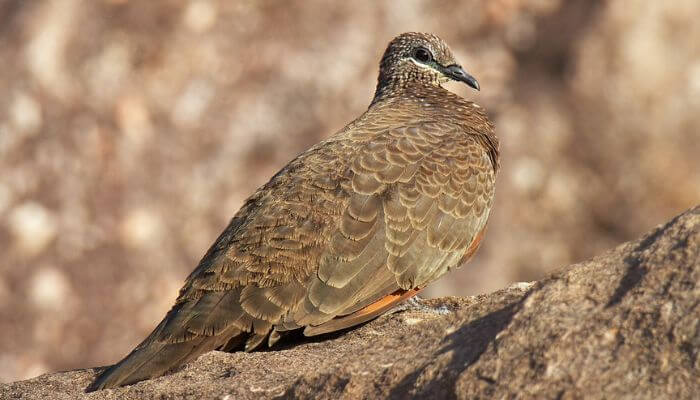The chestnut-quilled rock pigeon is a native pigeon of Australia.
It is distinguishable from other Australian pigeons by its coloring and markings.
Origins Of The Chestnut-Quilled Rock Pigeon
Australia has 26 native pigeon species and like with much of the continent’s wildlife, not a great deal is known about the origins.
Most particularly because due to being an isolated continent, Australia has unique wildlife not found anywhere else in the world.
It can only be assumed that the chestnut quilled rock pigeon evolved from the basic rock pigeon species in the same way as all other natural pigeon species around the world. That is, there was no human intervention in their creation.
The first recorded mention of this species was by Ludwig Leichhardt, a German naturalist who observed it near the head of the South Alligator River in North Territory on November 11th, 1845.
Closest Relatives Of The Chestnut-Quilled Rock Pigeon
The chestnut-quilled rock pigeon is very similar to its closest relative, the white-quilled rock pigeon.
In avian terms, they share the same giss, the term used to describe the overall appearance or habitual movements or behavior or location. This might be shape, posture, style of flight, size, coloring, vocalizations or habitat.
In the case of the two types of quilled rock pigeons, they share similar coloring but with different distinctive marks and a love of the same habitat in the same-ish region.
Distribution And Habitat Of The Chestnut-Quilled Rock Pigeon
The chestnut-quilled rock pigeon has a small range extending from about Pine Creek and Katherine to the East Alligator River and into Kakadu National Park and Western Arnhem Land in the Northern Territory.
The preferred habitat is areas of sandstone gorges and escarpments, with grass and shrubs in between scattered rocks and/or outcrops.
This species likes to roost on high rocky cliffs or on top of sandstone towers, and they have a routine of coming down to the surrounding sandy ground in the early mornings and evenings.
The chestnut-quilled rock pigeon prefers to walk rather than fly and has evolved to be capable of walking on very hot rock surfaces under the Australian sun.
Status Of The Chestnut-Quilled Rock Pigeon
As of 2022, the chestnut-quilled rock pigeon is categorized as being of ‘Least Concern’ on the IUCN Red List.
However, its Northern Territory Conservation Status is Near Threatened.
Appearance Of The Chestnut-Quilled Rock Pigeon
| Wingspan | Length | Weight | Coloring | |
|---|---|---|---|---|
| Chestnut-quilled Rock Pigeon | 13 – 16 cm | 28 – 32 cm | 130 – 180 g | Brown with chestnut wing patch |
| Average Feral Pigeon | 64 – 72 cm | 32 – 37 cm | 300 – 500 g | Bluish grey with some black |
A medium-sized short-legged bird, the chestnut-quilled rock pigeon is dark sooty brown in color, and it has a very distinctive bright chestnut patch on its wing that is visible when in flight and gives it its quirky name. This patch is often hidden when the bird’s wing is folded.
There is a faint blue-grey iridescence in the feathers and there are black lores and pale spots all across its neck, head and chin with a small off-white chin patch.

The chestnut-quilled rock pigeon has distinctive facial markings.
Pale grey lines run across the face, from the base of the upper mandible curving above and behind the eye, and from the lower mandible below the eye, curving across the sides of the head.
Character Of The Chestnut-Quilled Rock Pigeon
This species has a distinctive stance and they’ll be observed on a rock or ledge with their body held horizontally, tail held clear of the ground and the wings dropping below the tail.
Chestnut-quilled rock pigeons are most often seen when they have been flushed in small groups or pairs.
One of the signature moves that you might witness a chestnut-quilled rock pigeon executing is flying with loud clapping wing beats, often up a totally straight line from a gorge where they have been resting or hiding.
Quite sociable birds, they live in groups of 6 to 20 and communicate with a quiet double coo.
Diet Of The Chestnut-Quilled Rock Pigeon
The chestnut-quilled rock pigeon follows the same kind of diet that any other type of wild pigeon follows, and this essentially involves a variety of grains, greens, seeds, fruits and berries.
The most common herbaceous plant that a chestnut-quilled rock pigeon will eat is spinifex.
The birds will venture a few metres out into open woodland in order to find food, especially in the dry season when speargrass seeds are abundant. They will, however, quickly fly back to the safety of their sandstone at the first sign of any disturbance.
Chestnut-Quilled Rock Pigeon Mating And Breeding
Chestnut-quilled rock pigeons will breed from March to November each year, usually laying two creamy white eggs.
Both the male and female work to incubate the eggs which take about 17 days to hatch. Chestnut-quilled rock pigeon young will fly from their nest 21 days after hatching.
Chestnut-quilled rock pigeon nests are well hidden on shady ledges and built as a flatbed of roots and sticks.
When undiscovered, they will continue to use the same nest year after year unless forced to move and build another.
Taking Care Of The Chestnut-Quilled Rock Pigeon
Being a wild species, there are no specific care instructions for the chestnut-quilled rock pigeon from a ‘human’ perspective, but what you can focus on doing is protecting and preserving the very limited and specific areas of habitat in which the chestnut-quilled rock pigeon lives and thrives.
